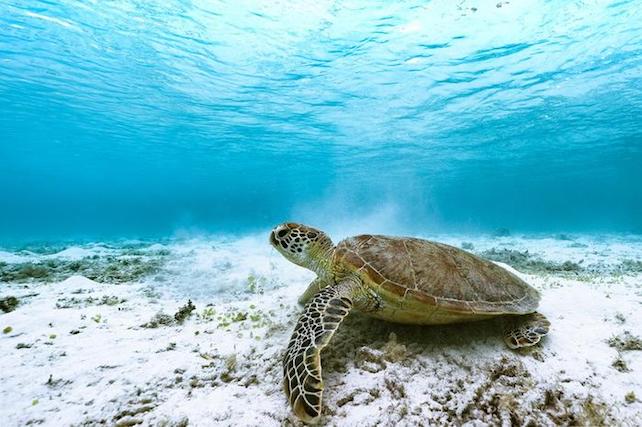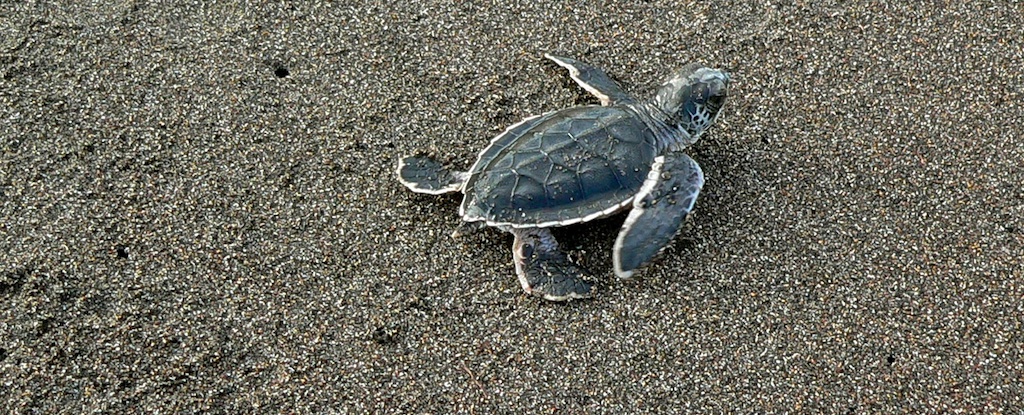Products You May Like
Green sea turtles are already an endangered species, mainly due to humans hunting them, harvesting their eggs, degrading their habitats, or entangling them in garbage of some kind.
But they also face another, more insidious threat from people: the loss of male hatchlings from the species.
You probably already know that this is partly caused by rising temperatures due to climate change – but a new study has now unveiled another human-caused problem driving this trend.
Certain pollutants may promote feminization in sea turtles, explains lead author Arthur Barraza, a toxicologist with the Australian Rivers Institute at Griffith University.
“Our research shows that the risk of extinction due to a lack of male green sea turtles may be compounded by contaminants that may also influence the sex ratio of developing green sea turtles, increasing the bias towards females,” Barraza says.
Green sea turtles (Chelonia mydas) have a vast geographical range, inhabiting tropical, subtropical, and temperate regions of the Atlantic, Pacific, and Indian oceans, as well as the Mediterranean Sea.
Male hatchlings are now heavily outnumbered by females overall, although the degree of imbalance varies in different parts of their range. In some warmer places like the northern Great Barrier Reef, researchers say, hundreds of female turtles are now born for every male.
That’s because sea turtles use temperature-dependent sex determination, meaning an embryo’s sex is determined by sand temperatures around its egg in the nest, with warmer sand favoring females. As temperatures rise around the world, male hatchlings are growing scarce.
But that’s not the only factor involved in determining sex, the latest research suggests.
In the new study, Barraza and his colleagues focused on green sea turtles at a long-term monitoring site on Heron Island, a small coral sand cay in the southern Great Barrier Reef.
Anywhere from 200 to 1,800 females nest there every year, the researchers report, and hatchlings born on the island have a more balanced sex ratio than those born closer to the equator, with only two or three females per male.
The researchers studied 17 clutches of green sea turtle eggs on the island, collecting them two hours after the mother laid them, then reburying them next to probes that would record hourly temperature data inside the nest and at the beach surface.

When the hatchlings emerged, researchers recorded their sex and tested them for 18 heavy metals like cadmium and chromium, plus organic pollutants like polycyclic aromatic hydrocarbons (PAHs), polychlorinated biphenyls (PCBs), and polybrominated diphenyl ethers (PBDEs).
“These contaminants are all known or suspected to function as ‘xenoestrogens’ or molecules that bind to the receptors for female sex hormones,” says senior author Jason van de Merwe, a marine ecologist and ecotoxicologist at the Australian Rivers Institute.
Female turtles accumulate these contaminants at their foraging sites, van de Merwe explains.
“As eggs develop within her, they absorb the contaminants that she accumulated and sequester them in the liver of the embryos, where they can stay for years after hatching,” he says.
On Heron Island, the study found varying sex ratios among the different clutches, but most nests yielded predominantly female hatchlings, the researchers report.
And the degree of female bias in each nest showed an association with xenoestrogen levels in the hatchlings, they discovered: higher pollutant levels in hatchlings’ livers correlated with a greater female bias in their nest.
More research is still needed to clarify whether these pollutants are contributing to differences in sex ratio, but the association already warrants concern, researchers say, given the existing dearth of male hatchlings plus the array of other dangers facing sea turtles.
“As the sex ratio gets closer to 100 percent females, it gets harder and harder for adult female turtles to find a mate, which is particularly important in the face of climate change already making nesting beaches warmer and more female-biased,” Barraza says.
In addition to reducing greenhouse gas emissions, this research suggests better control of some estrogenic pollutants might offer another way to mitigate the decline of male hatchlings.
“Determining which specific compounds can change the hatchling sex ratios is important for developing strategies to prevent pollutants from further feminizing sea turtle populations,” van de Merwe says.
“Since most heavy metals come from human activity such as mining, runoff, and pollution from general urban waste,” he adds, “the best way forward is to used science-based long-term strategies to reduce the amount of pollutants going into our oceans.”
The study was published in Frontiers in Marine Science.
